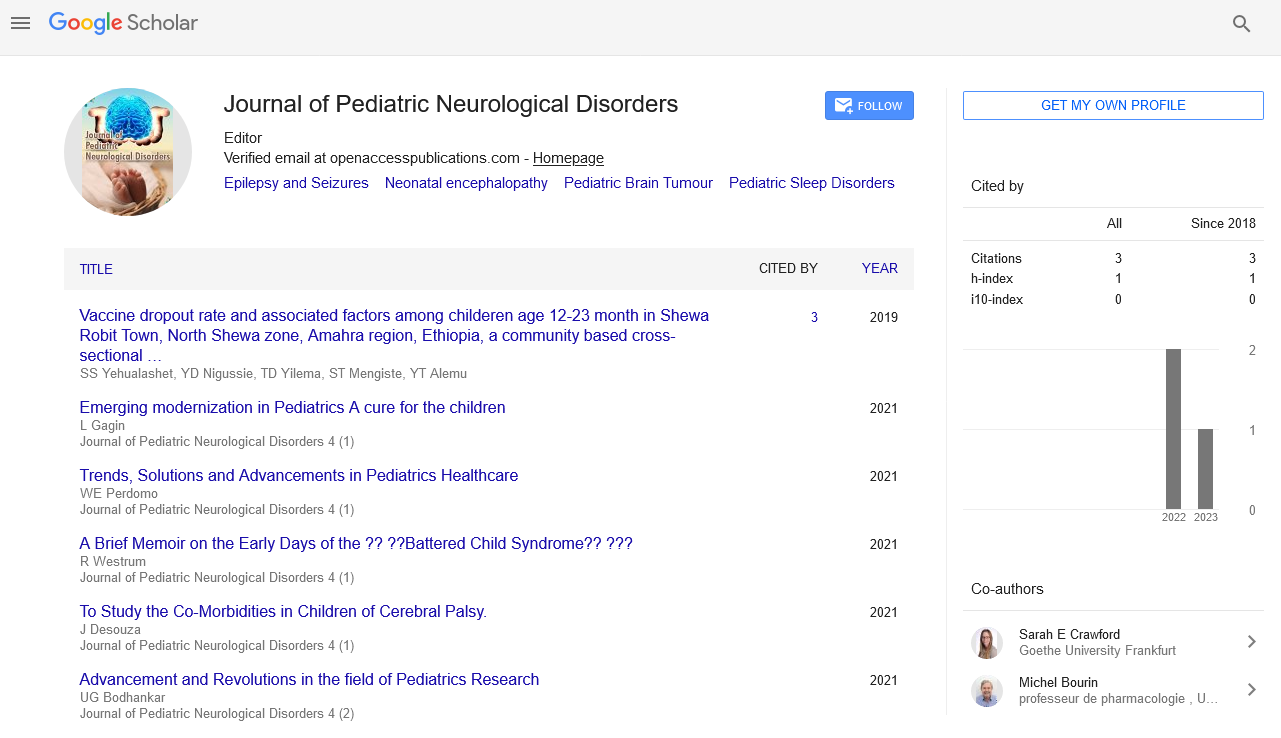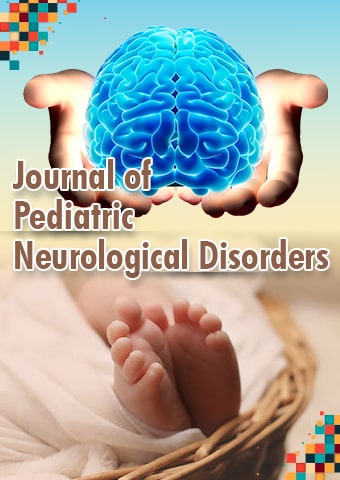Review Article - Journal of Pediatric Neurological Disorders (2023) Volume 6, Issue 4
Paediatric thoracic injury and traumatic brain damage: clinical importance and effects on ventilation
Linda Hollander*
Pasture Research Center, France
Pasture Research Center, France
E-mail: hollandr45@prc.ac.fr
Received: 01-Aug-2023, Manuscript No. pnn-23-111597; Editor assigned: 07-Aug-2023, PreQC No. pnn-23- 111597(PQ); Reviewed: 14- Aug- 2023, QC No. pnn-23-111597; Revised: 22-Apr-2023, Manuscript No. pnn-23-111597; Published: 31-Aug-2023, DOI: 10.37532/ pnn.2023.6(4).106-108
Abstract
Purpose
This study compares patterns of mechanical breathing in patients with or without accompanying moderate-to-severe Traumatic Brain Injury (TBI) and describes the epidemiology and management of chest trauma
Methods
This retrospective analysis included all kids who were referred to our level-1 trauma center after experiencing chest trauma between February 2012 and December 2018.
Results
There were 75 patients in all, with a median age of 11 [6-13] years with thoracic injuries. The majority of patients (n = 71, 95%) also had extra-thoracic injuries, and 59 (79%) also had TBI. 31 patients (41%) were receiving mechanical ventilation, and a total of 52 patients (69%) were admitted to intensive care. There was no change in tidal volume or positive end-expiratory pressure between patients with moderate-to-severe TBI and those with minimal or mild TBI in patients who needed mechanical ventilation. An isolated case of acute respiratory distress syndrome occurred in a patient. Six patients (8%) died overall, and all six had moderate-to-severe TBI.
Conclusion
The majority of the patients in this small retrospective cohort who required mechanical breathing after chest trauma also had associated moderate-to-severe TBI. The use of mechanical ventilation to treat TBI does not appear to be linked to an increase in cases of acute respiratory distress syndrome.
Keywords
Traumatic brain injury • Epidemiology • Chest trauma • Mechanical ventilation • Respiratory distress syndrome
Introduction
Worldwide, trauma continues to be a major factor in child mortality. According to the World Health Organization, 950,000 children under the age of 18 perished in injuries in 2004. Thoracic injuries, however rare, are prevalent in 4–8% of all pediatric trauma patients and are linked to greater mortality. A small percentage of children get cute Respiratory Distress Syndrome (ARDS) after trauma, but it is linked to worse outcomes. The management of mechanical ventilation in such patients presents clinicians with potentially conflicting paradigms; while tolerating moderate hypercapnia and hypoxemia may limit ventilator-induced lung injury, they are wellknown factors that worsen outcomes in patients with severe TBI [1].
In the current study, we hypothesized that the administration of mechanical breathing differs depending on whether a patient has a moderate-to-severe TBI associated with chest injuries. In this setting, the purpose of this study is to report a single-center cohort of pediatric patients who have experienced chest trauma and to compare mechanical breathing patterns in children who have experienced either accompanied moderate-to-severe TBI or not [2].
Methods
Study design
The sole level-1 pediatric trauma center in the French Alps, the pediatric trauma room at the Grenoble-Alps University Hospital, was the site of this monocentric retrospective analysis. The TRENAU (The Northern French Alps Trauma Sys- tem) registry comprised all patients under the age of 16 who were hospitalized to the trauma center between February 2012 and December 2018. Patients were included if the first admission report from the on-site doctor or the trauma leader indicated that they had chest trauma based on a clinical assessment and/or chest imaging [3].
Data collection
Electronic medical records (Clinisoft, General Electrics) were used to capture all of the data. Age and gender were included in the demographic data, and the mechanism of the injury and severity scores [Injury Severity Scores (ISS), Abbreviated Injury Score (AIS), Paediatric Trauma Score (PTS), and Paediatric Risk of Mortality (PRISM)] were included in the clinical data. Regarding the initial clinical assessment, hemodynamic failure was defined as the need for > 40 mL/kg of fluid or continuous infusion of vasopressors within the first 4 h after ICU admission, and moderate-to-severe TBI was defined by a Glasgow Coma Scale (GCS) 13 at ICU admission. Respiratory failure was defined as pulse oximetry 90% in room air at the scene. At the time of admission, a troponin level > 50 ng/L and/or cardiac dysfunction on cardiac ultrasonography were considered indicators of myocardial damage [4, 5].
Transfusions of blood products, non-orthopedic surgery, and invasive ventilation lasting longer than a day, and the use of vasopressors, neuromuscular blockers, or antibiotics during the first 24 hours were among the treatments noted. At admission, on days 2 and 3, the type and mode of mechanical ventilation, as well as the following variables—set FiO 2, Positive End- Expiratory Pressure (PEEP), Tidal Volume (V T), and pressure support level—were collected.
The final medical report was used to assess retrospectively the occurrence of ARDS (commonly diagnosed in accordance with the PALICC definition) and pneumonia (diagnosed in the context of fever, purulent tracheobronchial secretions, new or changing infiltrates on the chest radiography occurring > 48 h after admission, and confirmation by positive cultures). The length of time spent in the ICU and hospital, the time spent on mechanical breathing, the Paediatric Overall Performance Category (POPC) score at hospital release, and the rate of in-hospital mortality were all recorded outcomes. Patients are typically intubated in cases of 1) neurological failure (Glasgow Coma Score 8), 2) severe hemodynamic failure (SpO 2 92% despite proper care, including low-flow oxygen therapy), and 3) respiratory failure (SpO 2 89%). At admission, a cardiac ultrasound is conducted along with a full battery of biological tests, including Troponin [6f].
Results
Population study
75 (11.4%) of the 657 patients under the age of 16 who were admitted to our level-1 trauma center's ICU throughout the study period had chest injuries, and they were included in our analysis (Fig. 1). Table 1 lists the participant baseline characteristics. Their median age ranged from 6 to 13 years, and 50 of them (67%) were men. The primary cause of injuries (n = 45, 60%) was falls. The three most often found thoracic injuries were pneumothorax (n = 37, 49%), rib fracture (n = 14, 19%), and pulmonary contusion (n = 64, 85%). The majority of patients (n = 71, 95%) also had extra-thoracic injuries associated with them, the most common of which was TBI (n = 59) [7].
Ventilation management
Invasive mechanical breathing was needed by the majority of patients with moderate-to-severe TBI (n = 26, or 79%) as opposed to just five patients (12%) in the group with minimal or mild TBI (p 0.001). Four patients in total got noninvasive ventilation during their stay, and three of those patients afterwards needed invasive mechanical ventilation. (15%) individuals had chest tubes put in. Overall, just one patient experienced ARDS throughout his hospitalization, and he did not initially have a TBI [8 ].
Discussion
Only a small percentage of the kids in this retrospective research with chest injuries who were hospitalised to our level-1 paediatric trauma centre needed invasive mechanical breathing, and the majority of them had moderate-to-severe TBI as well. This is the first study to compare the effectiveness of mechanical ventilation in paediatric chest trauma patients based on the presence and severity of a Traumatic Brain Injury (TBI). Ventilatory settings are often established to reduce the risk of ventilator-induced lung injury based on adult recommendations because there are no guidelines for the ventilatory management of chest injuries in children. Although it is an uncommon side effect of chest trauma, ARDS, early lung-protective ventilation may help prevent it [9, 10].
Conclusion
According to this single-center, retrospective investigation, using mechanical ventilation to treat the most severe TBI patients who also have thoracic injuries does not appear to be related to a higher incidence of the acute respiratory distress syndrome. Which ventilation technique ought to be pushed in this group is still up for debate. The impact of mechanical ventilation practise outcomes in these patients who present with both thoracic and brain injuries as a result of trauma is suggested for more prospective studies.
References
- Geeraerts T, Velly L, Abdennour L. Management of severe traumatic brain injury. Anaesth Crit Care Pain Med. 37, 171-186 (2018).
- Bouzat P, Raux M, David JS. Chest trauma: first 48 hours management. Anaesth Crit Care Pain Med. 36, 135-145 (2017).
- Baker SP, O’Neill B, Haddon W Jr. The injury severity score: a method for describing patients with multiple injuries and evaluating emergency care. J Trauma. 14,187-196 (1974).
- Fiser DH. Assessing the outcome of pediatric intensive care. J Pediatr. 121, 68-74 (1992).
- Tovar JA, Vazquez JJ. Management of chest trauma in children. Paediatr Respir Rev. 14, 86-91(2013).
- Bliss D, Silen M. Pediatric thoracic trauma. Crit Care Med. 30, S409-415 (2002).
- Killien EY, Huijsmans RLN, Ticknor IL. Acute respiratory distress syndrome following pediatric trauma: application of pediatric acute lung injury consensus conference criteria. Crit Care Med. 48, e26–e33 (2020).
- Weerdenburg KD, Wales PW, Stephens D. Predicting thoracic injury in children with multitrauma. Pediatr Emerg Care. 35, 330-334 (2019).
- Baker SP, O’Neill B, Haddon W Jr. The injury severity score: a method for describing patients with multiple injuries and evaluating emergency care. J Trauma. 14, 187-196 (1974).
- Pollack MM, Ruttimann UE, Getson PR. Pediatric risk of mortality (PRISM) score. Crit Care Med. 16, 1110-1116 (1988).
Indexed at, Google Scholar, Crossref
Indexed at, Google Scholar, Crossref
Indexed at, Google Scholar, Crossref
Indexed at, Google Scholar, Crossref
Indexed at, Google Scholar, Crossref
Indexed at, Google Scholar, Crossref
Indexed at, Google Scholar, Crossref

